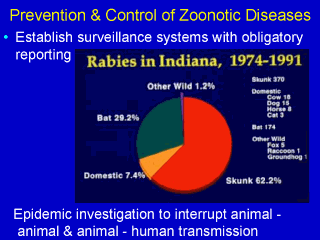Search for most updated materials ↑
|
|
|
|
front |1 |2 |3 |4 |5 |6 |7 |8 |9 |10 |11 |12 |13 |14 |15 |16 |17 |18 |19 |20 |21 |22 |23 |24 |25 |26 |27 |28 |29 |30 |31 |32 |review |
 |
The effective prevention and control of zoonotic infections in animal and human populations is based on well designed descriptive and analytic epidemiologic activities. First, it requires accurate measures of disease frequency and distribution. Second, the risk factors for transmission and susceptibility must be well characterized. Third, control programs should be critically evaluated and revised as needed.
In this slide, we see that approximately 60% of the rabies cases in Indiana are skunks, 30% bats, 7% domestic animals, and 1% other wild animals.
|